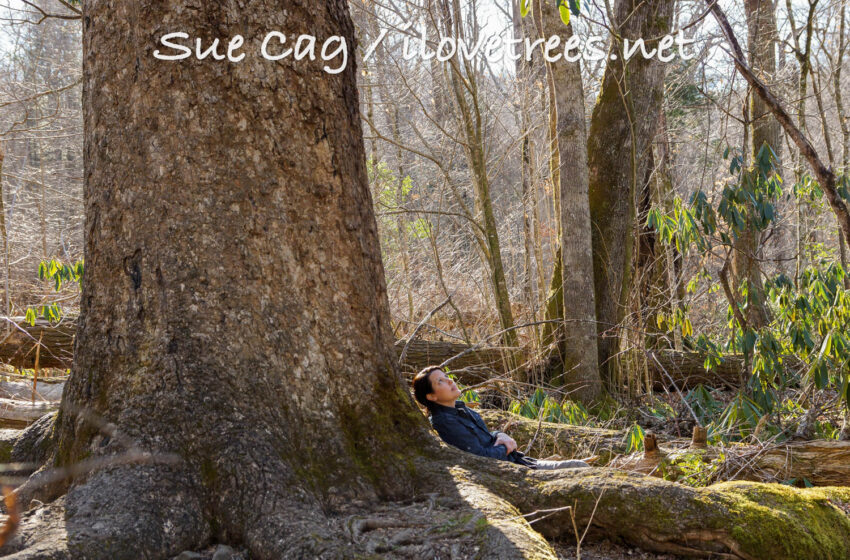It’s not easy to find old-growth forests in North Carolina. One can paddle the Black River to find old bald cypress trees hidden down maze-like channels of murky water. Or one can try to find patches or individual trees left over in the Great Smoky Mountains area. You might even find mature longleaf pine, if you’re lucky. You might also venture to The Joyce Kilmer Memorial Forest where you’ll find giant tulip trees (Liriodendron tulipifera) growing above a carpet of colorful wildflowers, a beautiful cove forest in the mountains of western North Carolina.
You may remember Joyce Kilmer for his famous poem “Trees” which begins “I think that I shall never see a poem lovely as a tree.” This forest is dedicated to him though he never stood foot in it. Certainly he would have loved it since it’s impossible not to – the tulip trees are so very impressive. It’s unusual to see such big trees in the eastern United States – and these are surely some of the biggest we have.
The tulip tree trunks rise from a thick bed of wildflowers and plants of all types. Emerald moss grows on their trunks. In the spring and summer their tall canopies create a dense umbrella overhead. In the winter the deciduous limbs look like candelabras. A thin trail loops around the cove, a narrow path through a sea of green life. The forest feels magical. It is a place of imagination made real, a fairytale world where anything is possible.
This precious forest is one of the few in the area that has never been cut by logging companies. Many of the tulip trees are over 300 years old and grow up to approximately 20 feet wide and 100 feet tall. Tulip trees usually take over after a disturbance such as logging or a storm, but I’m not sure if anyone knows exactly what was here before – our lives are so short and lacking in reliable natural history. We do know that the forest used to be full of American chestnut trees. These grand trees were killed by chestnut blight, a fungus that people brought to the eastern United States by importing foreign plants from Japan in the early 1900s. By 1940 all of our American chestnut trees were dead. Most people alive these days have never seen one. I’ve never seen one. I would have loved to see a forest of mature American chestnut trees. But I’ve been cheated. All of us should feel cheated. We should be surrounded by swaths of huge trees, old forest, virgin forest, but most of it has been decimated by logging or disease. Our views of trees these days consist of second, third, fourth growth runt-like inferior forests and our culture has conditioned us to not know any better.
The hemlocks have also been dying, again from a foreign invader that we brought from Japan – called hemlock woolly adelgid. See them while you can. And don’t wait to visit this forest either. These small patches of old-growth are all we have. They can easily be wiped out by storm or by fire. We have “put all our eggs in one basket” and managed only to conserve a little bit of virgin forest.
When you walk through The Joyce Kilmer Memorial Forest, you may feel as though you are walking through a dreamscape. You may wonder at the wild plants and flowers that grow without any involvement from us. You may even learn some of their names. But when you get home, take a close look around you. Is the place where you live brimming with big trees and carpets of native flowers? Was it ever before? How often do you get to see something natural and old? Do we value the magic of an old forest or do we think we can live without it?
Trees
by Joyce Kilmer
I think that I shall never see
A poem lovely as a tree.
A tree whose hungry mouth is prest
Against the earth’s sweet flowing breast;
A tree that looks at God all day,
And lifts her leafy arms to pray;
A tree that may in Summer wear
A nest of robins in her hair;
Upon whose bosom snow has lain;
Who intimately lives with rain.
Poems are made by fools like me,
But only God can make a tree.
![]() About the Author:
About the Author:
Sue Cag is a musician, artist, writer, photographer, and nature preservationist.
All photos and video by Sue Cag. All Rights Reserved. Photos and video may not be used without permission.


